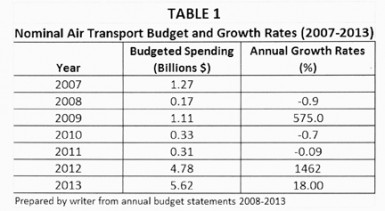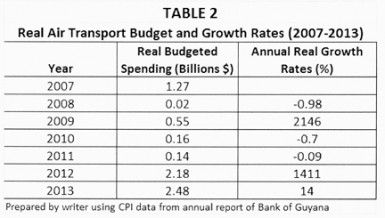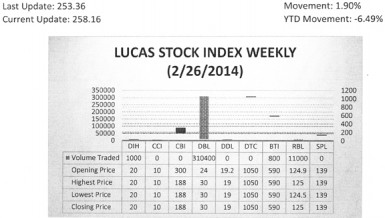Major thrust
A major thrust of this administration has been to invest in the physical infrastructure of the country. For the government, physical infrastructure that receives priority is roads and bridges, air and river transport, sea and river defence, drainage and irrigation, and electricity. It believes that this is the best way to transform the economy, develop the country and improve the lives of Guyanese. Capital spending that makes investment possible is a good thing for any country. Many of these investments like roads and bridges, and electricity are important inputs into the production process and make it possible for countries to expand output. The way that the administration speaks of its investment in the six areas above would make one believe that Guyana is the most progressive and efficient country in the world. From 2008 to 2013, in excess of $184 billion has been spent on physical infrastructure. Yet, the nation as a 
Insights
A review of spending from 2008 to 2013 offers some insights into which infrastructure projects the administration prefers to spend money on. The level of spending provides evidence of the emphasis. Over the period in review, the government spent in excess of $180 billion on various infrastructure projects. The largest share, $60 billion or about 32 per cent of the money, went to energy and power. This was followed by roads and bridges which received $55 billion or 30 per cent of the budgetary allocations. Spending on drainage and irrigation received $39 billion or 21 per cent of the money while allocations to sea and river defence reached $17 billion or nine per cent. Air and river transport obtained the least amount of money, $15 billion or just about eight per cent of the funds allocated. These allocations give an indication of what matters most to the administration, and suggest that they will continue to receive similar amounts in the 2014 budget.
To a large degree, the allocations to energy and power speak for themselves. The manoeuvres towards concluding a deal on the Amaila Falls hydropower project provided much impetus for spending in that area for the last few years, as did attempts to boost electricity supply and to inject new and improved technology into the system.
Disaggregation
A disaggregation of spending in each area of focus provides further evidence of the preference of the administration. Such an exercise is most useful for three of the areas with a twin focus, namely roads and bridges, air and river transport, and sea and river defence. The use of these categories appears to be more cosmetic than reflect a serious intent to improve the lives of Guyanese.
Starting with roads and bridges, one gets a sense that bridge construction and maintenance are not too important to the administration. In this category, the bulk of the money, 81 per cent, was spent on roads. Roads are important since they serve as an intermediate item in the production process. They aid development by allowing farmers to move produce easily. They encourage housing settlements and attract commerce.
Lack of interest
The preference for road work is further emphasized in the growth rate of the budgetary allocations. The money for roads grew by an annual average of 22 per cent. At the same time, the money for bridges went down by an annual average of six per cent. But, in many instances, the bridge is part of the road and the focus on roads with little attention paid to bridges could be disastrous. This likelihood should have been evident when the bridge over the Rupununi River collapsed in 2008 and very expensive machines went with it into the waters below. As if to give emphasis to the situation, one of the spans of the Demerara Harbour Bridge sank into the river about two years ago and it was only by the grace of God that there were no fatalities. The lack of interest in the condition of bridges ought to be of concern to Guyanese considering that the chance of rescue from a car in the water is virtually zero should the car go under water to any significant depth. Despite the high growth rate of spending on roads, many of these structures leave much to be desired. The number of roads with potholes and depressions raises the issue of whether the roads are being built and maintained as a means of granting contracts to a few friends of the administration as against increasing the productive capacity of the nation.
Variable investment
The other twin area of focus is that of air and river transport. Apart from receiving the least attention from the administration, air and river transport exhibit troubling performances. Admittedly, 69 per cent of the money spent on air and river transport is dedicated to air transport. Spending in this area has grown 404 per cent from 2009 to 2013. Still much more needs to be done to bring the sector up to acceptable standards. Money spent on this area over the past five years is less than seven per cent of the money spent on infrastructure development, notwithstanding the importance of the industry to the economy and the issue of safety to its users. Within the last year, there have been at least five incidents involving aircraft flying the skies of Guyana. Two of these five incidents resulted in fatalities. Persons familiar with the sector feel that the frequency of occurrence of air accidents is too high and deserves urgent attention. These events are significant and the paucity of investment in this area warrants the presentation of supporting data in the article. Some evidence of the inconsistent attention to, and variable investment in, this vital sector could be seen from the two tables below.
If what is taking place in air travel is bad, then it must be a nightmare for those using the rivers. This area has been neglected too and Guyana has seen many river mishaps in the past few years. Of all the items dealt with under physical infrastructure, river transport has received the shortest shrift. From 2008 to 2013, a mere $4 billion has been provided to take care of river transport, but nothing for river transport safety. Despite the resource size, the annual growth rate looks impressive at 116 per cent per annum. But, those living by and using the rivers must want to know if the money literally goes into the river and is never used for the purposes intended. Closer examination would reveal that river safety is not a matter of concern to the administration. The rivers of Guyana have proven a dangerous place to ply one’s trade or even to move from one destination to the next with very few navigational aids. The result is frequent river accidents and unhappy families. The budget needs to address that gap.
Another binary category is sea and river defence. It is not clear why the choice of words since no money ever seems to be put into river defence. Of the $13 billion set aside over the years for sea and river defence, it is impossible to tell which river communities are being defended and why. The thoughts on this matter need reexamination so as to ensure that money is being spent wisely.
Troubling picture
The investment in physical infrastructure presents a diverse and troubling picture for the development of Guyana. While the administration speaks of building a better Guyana, this effort is not being supported by the budget allocations on physical infrastructure. While the level of spending might be justified, there needs to be a shift in focus, especially to areas of safety.
LUCAS STOCK INDEX
The Lucas Stock Index (LSI) rose 1.90 percent in trading during the final week of February 2014. The stocks of four companies were traded with a total of 323,200 shares changing hands. There was one Climber and no Tumblers. The shares of Demerara Bank Limited (DBL) rose 25 percent on the sale of 310,400 shares. The shares of Banks DIH (DIH), Guyana Bank for Trade and Industry (BTI) and Republic Bank Limited (RBL) remained stable on the sale of 1,000; 800 and 11,000 shares respectively.








